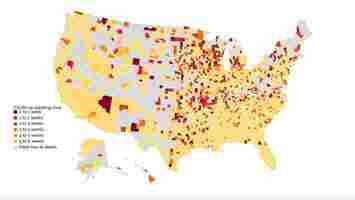Social media’s ‘queer tax’ is exhausting, unfair, and unavoidable
A colleague recently sought my advice on covering a queer-related tech topic and I’m not ashamed to admit I advised them against it.

I’m queer. I made the decision to come out in my professional life after a lot of consideration and long discussions with my family.
In the time since, I’ve learned that millions of people who’ve never met me hate me. They despise me for existing. They think I should go away, shut up, and stop being who I am. I offend them.
That’s not something I experienced before I came out.
And if you ask me those people are too sensitive. Don’t worry about my queerness. Think of it like a joke.
When I got up today, I was excited to write about this incredible press release from the American Institute of Physics .
Researchers believe they’ve managed to quantify all of the information in the known universe. It’s potentially groundbreaking.
I would absolutely love to spend the next 800-1200 words telling you about the potential implications for this research. But I’m tired… I’m exhausted. It’s barely lunch and I feel like I’ve been through the ringer.
A certain streaming company is currently involved in a kerfuffle around a popular entertainer and an employee protest. I’m not here to talk about that.
But I can’t avoid it! It’s on every news aggregator. It’s all over the most popular internet forums. My entire social media feed is full of commentary on queerness right now and it all sucks.
And, for the record, I spent a decade in the military during the longest war in US history and I talk a lot of trash about big tech on the internet — I’m pretty sure I’m not sensitive.
I’m not personally bothered by what a comedian says about queer people. What bothers me is knowing that trans women in 2021 are among the most at-risk groups in US history . They’re killed at a higher rate than any other identity group — with 350 known murders in just 2020 alone .
What bothers me is that I’m a US citizen who fought in a war only to come home to a country where it’s legal for businesses in several states to fire me for thinking dudes can be hot.
Thank you for your service, but I disagree with your lifestyle.
I don’t want to deal with any of that. But I’m forced to. I have to reckon with the fact that I’m incredibly privileged. My employer won’t fire me for this article. I’m one of the few queer people with a platform and, because of that, I have a responsibility.
But, damn it, I wanted to write about something I love today. I wanted to share my exuberance for physics and this amazing universe we all call home.
Yet here we are. Netflix and millions of “comedy fans” are out militantly defending their right to hold the existence of queer people in contempt.
And it’s unavoidable. I can’t just keep my head down and do my job. I can either hide my existence or be a target. It’s the closet or the grinder.
They comment on my work when it has nothing to do with queer issues. I get emails and DMs condemning me for queer ideas I’ve never espoused. They don’t care what I have to say. I’m just another member of the “Alphabet People” with a rainbow flag and a check mark on Twitter.
Every single time I publish anything related to queer issues in STEM, I’m exposed to hate. I know that I’ll get emails and comments filled with hate speech the moment I publish this. And trust me when I tell you there’s a difference between hate mail and mail that contains hate speech .
I get paid the same whether I fight this fight or avoid it. I know what it means to make these choices.
And I’m not even a queer journalist or a queer activist. I’m just a regular tech journo who happens to be queer. The people staging walkouts, leading activist groups, or even just writing for queer-centric media outlets are on the frontlines taking the brunt of the nastiness and bigotry. They’re immersed in it.
There’s just so many bigots in STEM that nary a day goes by where I don’t catch some secondary hate.
Days like today it’s nearly impossible to do my job without compartmentalizing. One moment I’m researching quantum physics and the next I’m reading a physicist’s commentary insinuating that being queer is a choice (and a very poor one) and that people like me are a distraction.
Some days you show up for work and millions of people are pissed off that you exist; that you have the audacity to think differently than them. And nobody gives you an extra break or compensates you.
And, when they attack me, I’m just supposed to prove them all wrong by doing my best work, by outclassing them. By being better than them.
I’m supposed to work twice as hard as them under circumstances that would make most of them crumble.
Under these conditions, it’s easy to see why queer people are underrepresented in STEM and why so many choose to remain closeted. Why so many quit and leave the fields they trained for.
Luckily there’s a simple solution. Pay us for that work. Compensate us for the extra taxes we endure just by existing. Recognize that queer people wade through a river of bullshit just to get through the door every single day.
It’s time for big tech to put its money where its mouth is. Because next June you can be assured that Netflix and similar outfits that struggle with diversity issues will be sporting rainbow logos and releasing self-congratulatory diversity reports.
Thanks but no thanks. I can’t speak for anyone else, but I believe most of us would rather get a pay raise or a promotion than be subjected to another round of fake, performative allyship from a company willing to both-sides issues of bigotry and hate.
This AI spots local COVID-19 outbreaks before they’ve spun out of control
Researchers have developed a new machine learning-based tool that detects potential COVID-19 outbreaks in individual US counties.

The system makes its assessments by analyzing reported COVID-19 cases and deaths, rates of positive tests, face mask rules, social distancing policies, and changes in testing.
It also incorporates the Centers for Disease Control and Prevention’s Social Vulnerability Index , which assesses how individual communities are prepared for hazardous events based on factors including poverty and population density.
It then predicts how fast the virus is spreading by estimating how many days it will take for the number of cases to double.
The forecasts are displayed on an interactive heat map that shows each county’s doubling rate. Users can also see the area’s population, new cases, and average daily cases, all of which is updated two-to-three times per week.
The system was developed by researchers from Massachusetts General Hospital, Harvard Medical School, Georgia Tech, and Boston Medical Center. Jagpreet Chhatwal, an assistant professor at Harvard Medical School, said it could reduce the spread of infections by identifying COVID-19 hotspots to isolate from their neighbors:
In tests, the tool verified an outbreak last week in Johnson county Iowa, which was linked to a surge in cases at the University of Iowa. It also identified several counties where potential outbreaks could be happening now, including Harrisonburg County in Virginia, Wheeler County in Georgia, Monroe County in Indiana, and Whitman County in Washington.
You can see how things are looking in your home county by checking out the COVID-19 Outbreak Detection Tool .
So you’re interested in AI? Then join our online event, TNW2020 , where you’ll hear how artificial intelligence is transforming industries and businesses.
Adventures with AI: Here’s what happened when I ate a three course meal designed by artificial intelligence
Welcome to Adventures with AI, a column exploring what happens when artificial intelligence takes control of everyday tasks.

Eating out is one of my great pleasures; cooking is not.
Unfortunately, since the onset of the COVID-19 pandemic, I’ve been doing a lot of the latter and almost none of the former.
Preparing meals has become particularly tedious during London’s latest lockdown. So like an unhappy couple in a sexless marriage, I’ve been trying to spice things up in my domestic life. Only instead of strapping on a gimp mask and a ball gag, I’ve been experimenting with AI.
I first sought culinary inspiration from GPT-3, a text generator that’s destined to either Take Over The World or burn out in a blaze of bigotry and pseudophilosophy .
The model’s been trained on a gobsmacking quantity of data, including the entire English-language Wikipedia, two vast corpora of books, and a filtered version of the Common Crawl . With so many recipes now online, GPT-3 must have learned its way around the kitchen. Right?
I put my stomach on the line to find out.
L’entree
Access to GPT-3 remains prohibitively pricey for most, but the nutritional boffins at Refluxgate kindly provided me with a selection of its recipes.
For my starter, I whipped up a plate of honey and soy-glazed vegetables.
The model suggested every ingredient you’d expect from such a dish — except for the vegetables.
Thank the Kitchen Gods it recommended serving this monstrosity with rice:


The dish was gloopy and overpowering but somehow palatable. Certainly not something I’d ever cook again, but if I were the last man on Earth and it was the last food on Earth, and the future of the human race depended on us? I’d probably eat my own foot.
Perhaps I’m being unfair. A steady diet of fast food and cigarettes may have rendered my tastebuds incapable of appreciating GPT-3’s subtle flavors. Have I judged the model too harshly?
I asked someone with a more sophisticated palate: Ellen Parr, the head chef of London restaurant Lucky & Joy .
She was not impressed:
Still, it was edible enough to give me hope for my main course: a GPT-3-generated tomato sauce, served on a Tom-generated bed of tagliatelle.
Le plat principal
I like my meals like I like my stories: with a beginning, middle, and end. But this main course made me wish I could skip to the epilogue.
There’s no polite way of saying this: it looks like a turd. One of those really disgusting turds that make you question your life choices.
In fairness, it tasted better than it looked — but not by much. GPT-3 recommended so much raw garlic I felt like I was eating a vampire’s nightmare. On the plus side, the garlic suppressed the flavor of the undercooked tomatoes.
Parr spotted some other dubious tips in the recipe:
There were further shortcomings in GPT-3’s other recipes. They were often hard to follow, lacked attention to detail, and sometimes suggested unsafe practices, like putting a casserole dish on a hot stove.
Refluxgate’s lead researcher, Mel Kasulis, told TNW that the problems stem from the model’s training data:
GPT-3 also showed a curious admiration for Gordon Ramsay. The model credited every one of its recipes to the sweary Scottish chef.
Ramsay’s vast empire of restaurants, cookbooks, and TV shows has clearly extended across vast swathes of the internet.
Le dessert
I’ve been living alone during the pandemic (*sniff*), which means there’s been nobody around to compliment my extraordinary concoctions.
The solitude has also driven me slightly mad. So last week I decided to move back in with my momz.
To show my appreciation for her hospitality, I generously offered to cook her an AI-generated recipe.
Now, I’m obviously a disappointing son, but not so disappointing that I’d feed her a vegetable dish with no vegetables. Instead, I whipped her up some pancakes.
I used the method recommended by software firm Monolith AI , which generated it by training a machine learning model on 31 recipes for US-style fluffy pancakes.
It was undoubtedly the best AI recipe I tried.
Even my Belgian mum was impressed by the American pancakes — to an extent:
Le digestif
After a good meal, there’s nothing I enjoy more than a stiff drink.
I’m no mixologist, but a man called Tim, who writes code, has a YouTube channel called Tim writes code, where he recently shared some GPT-3-generated cocktail recipes, including one called Tim writes code.
However, I didn’t make that one. Not because I don’t like Tim and his code, but my dwindling liquor cabinet didn’t have the booze required for that elaborate concoction.
Instead, I tried the equally imaginatively-named GPT-3, a mix of vodka, lime juice, and blueberry syrup, garnished with a lime wheel.
The cocktail was extraordinarily sweet, which was just fine by me. But would it impress the experts?
I asked Peter Kelly, bar manager at the aforementioned Lucky & Joy, whether he’d consider serving it up:
He didn’t envision GPT-3 earning Michelin stars, but did see some potential for AI in the kitchen.
“It might be beneficial if you can type in some ingredients and it can generate something for you. That’s economical and potentially gets rid of wastage.”
Mel Kasulis from Refluxgate had higher hopes for GPT-3’s future in recipe design:
As for me, I’ve got mixed thoughts on AI’s culinary skills. It certainly created some original recipes that no decent chef would have designed. Unfortunately, the starter and main course were absolutely horrendous.
Still, they can’t have been that bad; I ate every morsel and left the table satiated. But my stomach will never forgive me .
Greetings Humanoids! Did you know we have a newsletter all about AI? You can subscribe to it right here .